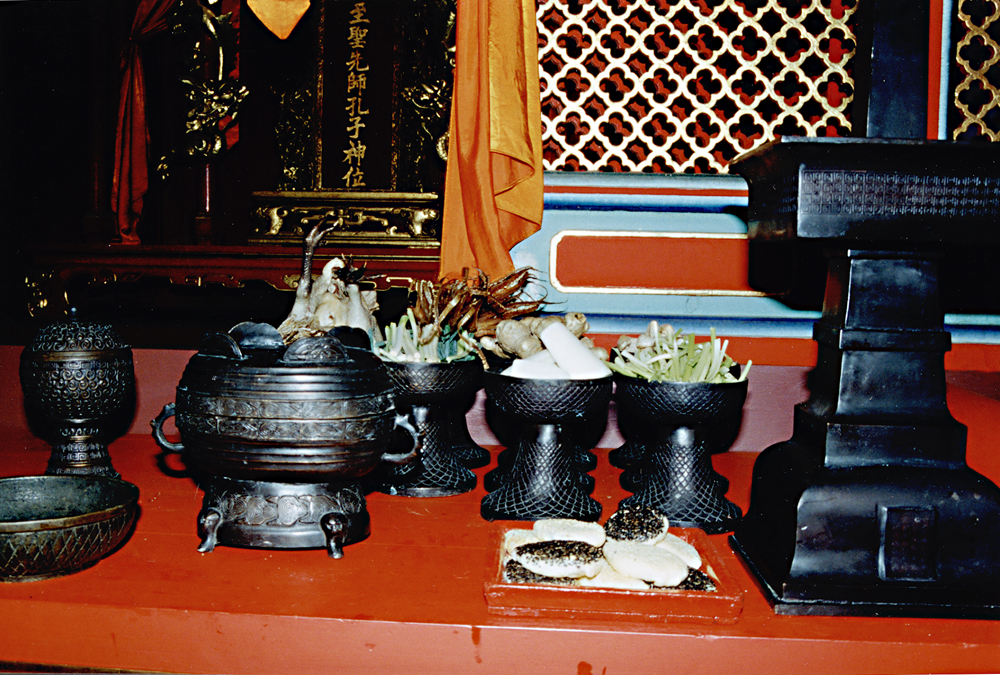
Canonization of Confucius
The imperial court promoted Confucianism by posthumously ennobling Kongzi, first as duke and later as king. In addition to elevating the figure of Kongzi to ever greater status, emperors also conferred hereditary titles of nobility upon his descendants, initially as marquises, and by Song times as dukes; a position Kongzi's descendants held until the 1940s. Critical to this careful attention to the person of Kongzi as the embodiment of the literati tradition was the state cult, which centered upon offering sacrifices to Kongzi's spirit in the Kong temple.

An altar with offerings for sacrifice
An important event in the canonizing process occurred in 195 B.C., when the founding emperor of the Han dynasty, Han Gaozu (r. 206-195 B.C.), offered a Great Sacrifice to the spirit of Confucius at his tomb in Qufu. As early as 241, sacrfices to the spirits of Kongzi and his most prominent disciple, Yan Hui, were offered in the Imperial University (Biyong). The picture on the left shows the Imperial University in Beijing.
Posthumous Titles Conferred to Kongzi
- 478 BCE (Jingwang 42): Duke Ai of Lu posthumously confers title of Venerable Ni
- 1 CE (Western Han dynasty: Emperor Ping, 1st year/6th month/10th day of the Yuanshi era): Exalted Ni Duke of Consummate Perfection (Baocheng xuan Ni gong; Ni is a reference to Mt. Ni, southeast of Qufu, where Kongzi's mother prayed for a child before he was born.)
- 492 (Latter Wei: Emperor Xiaowen, Taihe 16/2/21): Sage of Culture Venerable Ni (Wensheng Nifu)
- 580 (Latter Zhou: Emperor Jing, Daxiang 2/3/1): Duke of the state of Zou (Zouguo gong)
- 608 (Sui: Emperor Yang, fourth year of the Daye era): First Teacher Venerable Ni (Xianshi Nifu)
- 628 (Tang: Emperor Taizong, Zhenguan 2/12): First Sage (Xiansheng)
- 637 (Tang: Emperor Taizong, Zhenguan 11): Exalted and Venerable (Xuanfu)
- 657 (Tang Emperor Gaozong, Xianqing 2): restored to First Sage (Xiansheng)
- 739 (Tang: Emperor Xuanzong, Kaiyuan 27/8/23): Exalted King of Culture (Wenxuan wang)
- 1008 (Song: Emperor Zhenzong, Dazhong xiangfu 1/10/1): Dark Sage and Exalted King of Culture (Xuansheng wenxuan wang)
- 1013 (Song: Emperor Zhenzong, Dazhong xiangfu 5/12/29): Ultimate Sage and Exalted King of Culture (Zhisheng wenxuan wang)
- 1307 (Yuan: Emperor Wu, Dade 11/7/18): Great Completer, Ultimate Sage and Exalted King of Culture (Dacheng zhisheng wenxuan wang)
- 1370 (Ming: Hongwu 3/6/6): noble titles for all gods and spirits of the imperial pantheon eliminated (e.g., 5 sacred peaks, the 4 seas); only Kongzi's (and other figures enshrined in the Kong temple) title is retained.
- 1530 (Jiajing emperor 9): Ultimate Sage, First Teacher Master Kong (Zhisheng xianshi Kongzi)
- 1645 (Qing: Shunzhi emperor, 2/1/23): Great Completer, Ultimate Sage, Exalted First Teacher of Culture (Dacheng zhisheng xianshi Kongzi)

A portrait of Confucius

A portrait of Confucius with Chinese characters
